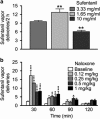Compulsive-Like Sufentanil Vapor Self-Administration in Rats
- PMID: 28812595
- PMCID: PMC5809787
- DOI: 10.1038/npp.2017.172
Compulsive-Like Sufentanil Vapor Self-Administration in Rats
Abstract
Opioid misuse is at historically high levels in the United States, with inhalation (ie, smoking and vaping) being one of the most common routes of consumption. We developed and validated a novel preclinical model of opioid self-administration by inhalation that does not require surgery and reliably produces somatic and motivational signs of dependence. Rats were trained to perform an operant response (nosepoke) to receive 10 s of vaporized sufentanil, a potent opioid, in 2 h daily sessions. Rats readily and concentration-dependently self-administered vaporized sufentanil. Rats exhibited a significant increase in responding for sufentanil when given the preferential μ-opioid receptor inverse agonist naloxone, suggesting the participation of μ-opioid receptors in the reinforcing properties of sufentanil vapor. Serum sufentanil concentrations significantly correlated with the number of sufentanil vapor deliveries. Rats that were given long access (LgA; 12 h/day) but not short access (ShA; 1 h/day) to vaporized sufentanil escalated their drug intake over time and exhibited both naloxone-precipitated somatic signs of opioid withdrawal and spontaneous withdrawal-induced mechanical hypersensitivity. After 6 months of forced drug abstinence, LgA rats returned to pre-escalation baseline levels of responding for sufentanil and mechanical sensitivity. Upon subsequent re-escalation (ie, after the return to extended access to sufentanil vapor), LgA rats again developed naloxone-precipitated somatic signs of withdrawal and spontaneous withdrawal-induced mechanical hypersensitivity. These findings demonstrate that the operant sufentanil vapor self-administration model has both face and construct validity and therefore will be useful for investigating the neurobiological basis of opioid addiction.
Figures




References
-
- Ahmed SH, Walker JR, Koob GF (2000). Persistent increase in the motivation to take heroin in rats with a history of drug escalation. Neuropsychopharmacology 22: 413–421. - PubMed
-
- Centers for Disease Control and Prevention (CDC) (2008). Nonpharmaceutical fentanyl-related deaths—multiple states, April 2005-March 2007. MMWR Morb Mortal Wkly Rep 57: 793–796. - PubMed
-
- Chaplan SR, Bach FW, Pogrel JW, Chung JM, Yaksh TL (1994). Quantitative assessment of tactile allodynia in the rat paw. J Neurosci Methods 53: 55–63. - PubMed
Publication types
MeSH terms
Substances
Grants and funding
LinkOut - more resources
Full Text Sources
Other Literature Sources
Research Materials

